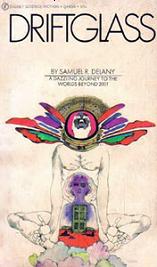
Driftglass
Samuel R. Delany
318 pages
published in 1971
Samuel Delany is one of my favourite science fiction writers and in my opinion one of the best science fiction writers ever. Considering the cover blurb on this collection of short stories, I'm not alone in that opinion. According to Frederick Pohl, not a bad writer himself, "Delany may be the only authentic genius among us". High praise indeed, but Delany deserves it. Everything I've read of his, including his earliest novels, displayed a mastery of both language and story, a lively imagination and ability to create novel bt believable world and most importantly a grasp of the importance of culture that's rare in science fiction, especially when he first started writing.
He is however more of a novelist than a short story writer, having written not nearly as many short stories as his contemporaries. in fact, Delany debuted with a novel at a time when science fiction was still largely a magazine driven field. It was only after he had establishred himself as a writer that he started publishing some of his short stories. Driftglass was his first collection, containing work written between '65 and '68 and published between 1967 and 1970. It's a great collection, with two absolute classics in it: the Nebula winning "Aye, and Gomorrah..." as well as "Time Considered as a Helix of Semi-Precious Stones", which won both the Hugo and the Nebula awards. Not to mention several other excellent stories.
There are two ways in which you can read any short story collection. You can either read them one story at a time, dipping in and out according to mood, or you cann just read it straight through like any other book. I've never had the patience for the first, not to mention that it's all a bit precious, so I've always treated a short story collection as any other book. This does have its disadvantages, not in the least that you can get sick of the repeated idiosynchranities of a specific writer, as happened to me with the Lovecraft collection I read recently. On the other hand it's always interesting to see recurring themes and images in a writer's work, especially with such a good writer like Delany.
There are several elements that keep recurring in these stories, though not necessarily in each of them. One image in particular keeps cropping up, that of "fingers that were all knuckles and bitten nail" as he put it in "Time Considered as a Helix of Semi-Precious Stones", or "the hand of a very big man who had bitten his nails since he was a very small boy" as he put it in "We, In Some Strange Power's Employ, Move in a Rigid Line". Corresponding with this image is that of a bare foot, dirty and blackened by walking on city pavements. It's an image Delany keeps using in his descriptions of certain of his characters. There's a definative macho, sexual power in these descriptions, something that stems from Delany's own fetishes, as shown in his autobiograpy The Motion of Light in Water. These are images that don't draw your attention in any single story, but become very noticable if you read several of his stories back to back.
Another recurring theme in Delany's stories is the setting. Several of the stories in this collection share a Mediterranean setting: "Dog in a Fisherman's Net" is set on a Greek Island, "Aye, and Gomorrah" in Istanbul, "Cage of Brass" partially in Venice. Another recurring setting is that of a port city, in some ways reminiscent of New York (or indeed, New York itself): "The Star Pit", "Corona" and "Time Considered as a Helix of Semi-Precious Stones" all share this setting. Come to think of it, most of the Mediterranean stories are also set in port cities. In each case it's the slums, the grimy and dirty docks and workspaces that feature prominently, as a sort of counterpoint to the grimy knuckles and hardbitten nails of Delany's characters perhaps.
Finally, what struck me most about these stories is how different they are from the classix sxience fiction puzzle story. Most sf short stories are idea driven, where the story revolves around some clever idea, trick or situation the writer thought up. A classic example being Isaac Asimov's Robot stories, which revolve around his three Laws of Robotics and the next loophole he found in them. Delany doesn't do this: with him everything revolves around the societies and cultures he has created. Everything he writes about is drenched in culture, especially music and poetry. Not that Delany doesn't do clever ideas; they'rejust on a different level. For example, "The Star Pit" revolves about the metaphor of an ant farm/miniature ecology, imagery of which keeps returning in the story and in the end the story is the metaphor.
- The Star Pit (1967)
- Dog in a Fisherman's Net (1971)
- Corona (1967)
- Aye, and Gomorrah... (1967)
- Driftglass (1967)
- We, in Some Strange Power's Employ, Move on a Rigorous Line (1968)
- Cage of Brass (1968)
- High Weir (1968)
- Time Considered as a Helix of Semi-Precious Stones (1968)
- Night and the Loves of Joe Dicostanzo (1970)
Read more about:
Samuel R. Delany,
Driftglass,
science fiction,
book review